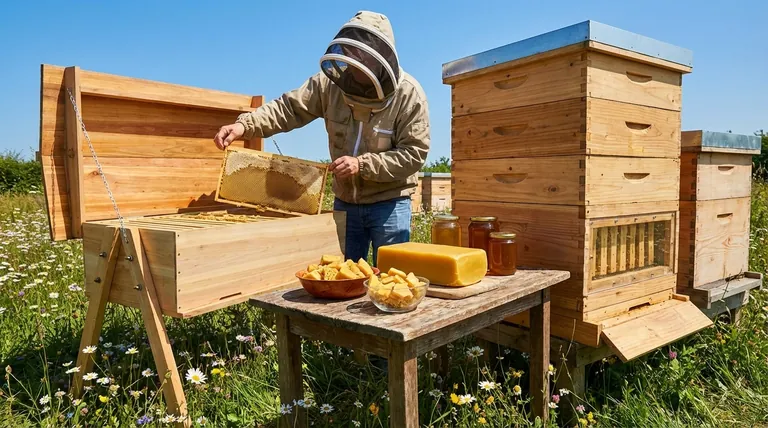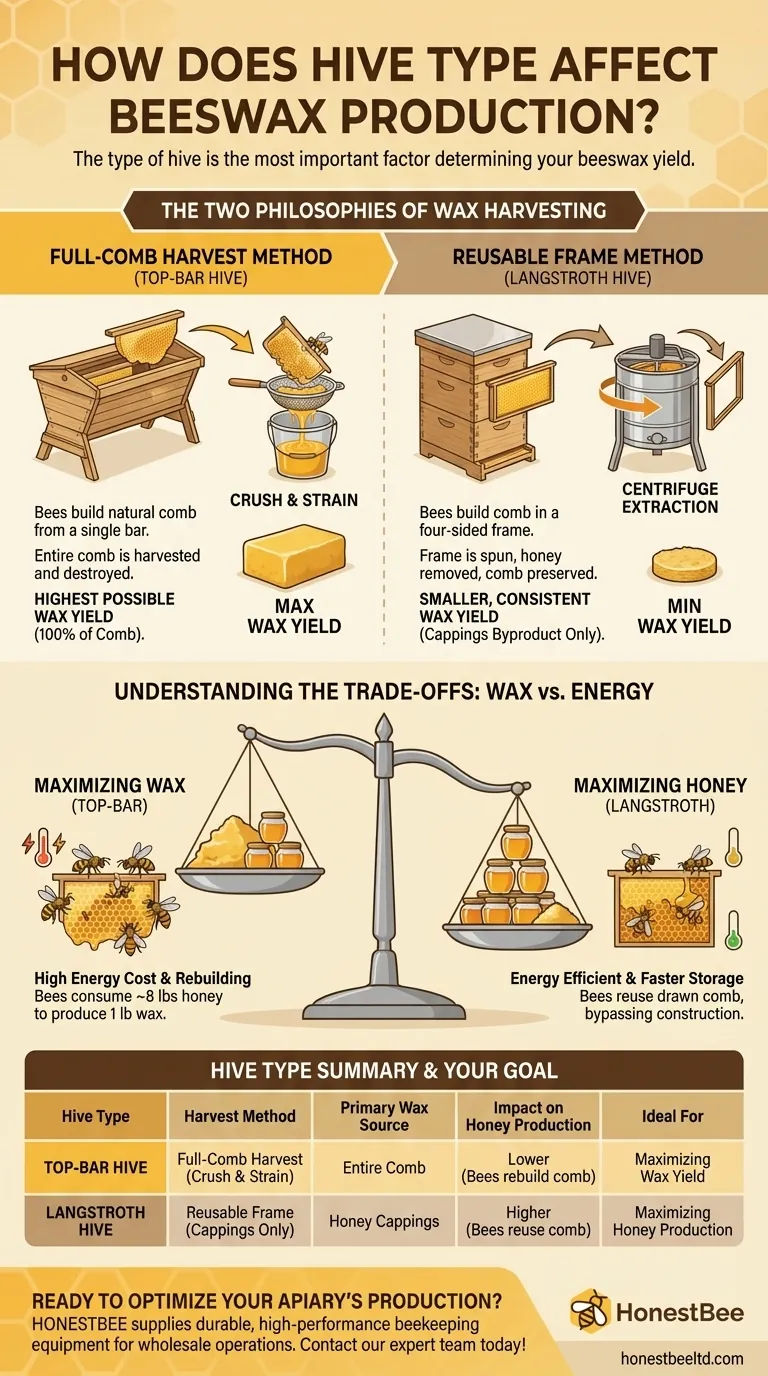The type of hive you choose is the single most important factor determining your beeswax yield. Hives designed for a full-comb harvest, such as Top-Bar or fixed-comb hives, produce significantly more beeswax because the entire comb is removed and processed. In contrast, modern moveable-frame hives like the Langstroth are designed to preserve the comb, resulting in a much smaller wax harvest composed mainly of the cappings sliced off during honey extraction.
Your choice of hive forces a strategic decision: are you optimizing for maximum wax yield or for honey production efficiency? Hives that produce more wax do so by requiring the bees to constantly rebuild their home, which comes at a direct cost to honey storage.

The Two Philosophies of Wax Harvesting
The difference in beeswax yield is not an accident; it is a direct result of two fundamentally different approaches to hive management and honey extraction.
The "Full-Comb Harvest" Method
Hives like the Top-Bar hive operate on a simple principle. Bees are given a single bar from which they build their comb downwards, naturally, without side supports.
To harvest, the beekeeper cuts the entire comb off the bar. The honey is then separated from the wax by crushing the comb and straining the mixture. This "crush and strain" method destroys the comb, but in doing so, it renders the entire structure as harvestable beeswax.
This method results in the highest possible wax yield per harvest because you are collecting 100% of the wax the bees used to build that section of their home.
The "Reusable Frame" Method
The Langstroth hive, the most common moveable-frame hive, is an efficiency-focused system. Bees build their comb inside a complete four-sided wooden frame.
During honey extraction, these frames are placed in a centrifuge. The spinning force extracts the honey without destroying the delicate wax comb structure. These intact, empty frames of "drawn comb" are then returned to the hive for the bees to refill.
The only wax harvested is the thin layer of "cappings" that bees use to seal the honey cells. This results in a much smaller but consistent wax yield that is a byproduct of honey production, not its goal.
Understanding the Trade-offs: Wax vs. Energy
Choosing a hive is not just about the equipment; it's about managing the bee colony's most precious resource: energy.
The Biological Cost of Wax
Beeswax is metabolically expensive for bees to create. The commonly accepted ratio is that bees must consume approximately eight pounds of honey to produce one pound of wax.
This is a critical factor. When you harvest the entire comb, you are forcing the colony to expend enormous energy and consume significant food stores to rebuild their home before they can store more honey.
Impact on Honey Yield
A colony in a Langstroth hive with a full set of reused, drawn-out frames has a major advantage. The bees can immediately begin foraging and storing nectar as honey, bypassing the energy-intensive construction phase. This is why frame hives are generally considered more efficient for maximizing honey production.
A Top-Bar hive colony, after a harvest, must divert its workforce and resources to wax production first. This rebuilding period means less time and energy are available for foraging, which can lead to a lower overall honey yield compared to a frame hive of similar strength.
Colony Management and Health
Moveable-frame hives allow for detailed inspection and manipulation. A beekeeper can remove a single frame to check the queen's laying pattern, identify pests, or rearrange resources within the hive.
Top-Bar hives offer a more "hands-off" approach, which appeals to many natural beekeepers. However, inspections can be more disruptive, as combs are more fragile and cannot be rearranged as easily.
Making the Right Choice for Your Goal
Your beekeeping goals should dictate your equipment choice. There is no single "best" hive, only the best hive for a specific purpose.
- If your primary focus is maximizing beeswax production: A Top-Bar hive is the clear choice, as the "crush and strain" harvest method renders the entire comb from every harvested bar.
- If your primary focus is maximizing honey production: A moveable-frame hive like a Langstroth is far more efficient, as reusing comb saves the bees immense energy that can be redirected to honey storage.
- If your primary focus is a low-intervention or "natural" approach: The Top-Bar hive's design encourages less frequent manipulation, though the Langstroth remains the standard for its ease of inspection and problem-solving.
Understanding this fundamental trade-off between wax and energy empowers you to choose the hive that truly aligns with your beekeeping philosophy.
Summary Table:
| Hive Type | Harvest Method | Primary Wax Source | Impact on Honey Production | Ideal For |
|---|---|---|---|---|
| Top-Bar Hive | Full-Comb Harvest (Crush & Strain) | Entire Comb | Lower (Bees rebuild comb) | Maximizing Wax Yield |
| Langstroth Hive | Reusable Frame (Cappings Only) | Honey Cappings | Higher (Bees reuse comb) | Maximizing Honey Production |
Ready to optimize your apiary's production? Whether you're a commercial apiary focused on wax or honey, HONESTBEE supplies the durable, high-performance beekeeping equipment you need to succeed. Our wholesale-focused operations provide the reliable gear that supports your specific goals. Contact our expert team today to discuss your hive and equipment requirements!
Visual Guide

Related Products
- Long Langstroth Style Horizontal Top Bar Hive for Wholesale
- HONESTBEE Advanced Ergonomic Stainless Steel Hive Tool for Beekeeping
- Multi-Functional Sliding Hive Entrance for Beekeeping
- Professional In-Hive Bee Feeder HONESTBEE Frame for Beekeeping
- Top Bar Beehive for Beekeeping Wholesales Kenya Top Bar Hive
People Also Ask
- What is a top bar bee hive? A Natural, Low-Stress Beekeeping Solution
- How does the top bar hive help control varroa mites? A Natural Approach to Mite Management
- What are the box management requirements for a top bar hive vs. Langstroth? Choose Your Hive Strategy
- What are the main differences between Langstroth hives and top bar hives? Choose the Right Hive for Your Beekeeping Goals
- How does the design of a top bar hive benefit beekeepers? Ergonomic & Natural Beekeeping for Hobbyists



















